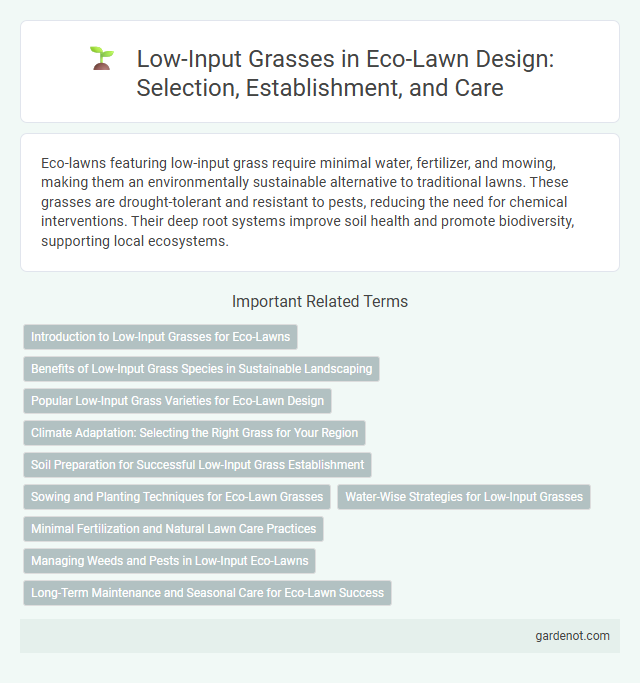Eco-lawns featuring low-input grass require minimal water, fertilizer, and mowing, making them an environmentally sustainable alternative to traditional lawns. These grasses are drought-tolerant and resistant to pests, reducing the need for chemical interventions. Their deep root systems improve soil health and promote biodiversity, supporting local ecosystems.
Introduction to Low-Input Grasses for Eco-Lawns
Low-input grasses for eco-lawns include native species such as fescues, bluegrasses, and buffalo grass that require minimal water, fertilizer, and mowing. These grasses improve soil health by enhancing microbial activity and reducing erosion while supporting biodiversity by providing habitats for pollinators and beneficial insects. Implementing low-input grass varieties significantly reduces maintenance costs and environmental impacts compared to traditional turfgrass.
Benefits of Low-Input Grass Species in Sustainable Landscaping
Low-input grass species require minimal water, fertilizer, and pesticide applications, significantly reducing environmental impact and maintenance costs in sustainable landscaping. These grasses enhance soil health by promoting biodiversity and improving water retention, which contributes to ecosystem resilience. Their adaptability to local climates reduces resource consumption and supports long-term landscape sustainability.
Popular Low-Input Grass Varieties for Eco-Lawn Design
Fine fescues, including creeping red fescue and chewings fescue, are popular low-input grass varieties for eco-lawn design due to their drought tolerance and minimal fertilizer requirements. Buffalograss thrives in warm climates with low water needs, making it ideal for sustainable landscaping. Kentucky bluegrass blends well with native grasses to create resilient eco-lawns with reduced maintenance demands.
Climate Adaptation: Selecting the Right Grass for Your Region
Low-input grasses such as fine fescues and buffalo grass thrive under minimal irrigation and fertilization, making them ideal for eco-lawns in drought-prone areas. Climate adaptation demands selecting grass species that match regional temperature and precipitation patterns to ensure resilience and sustainability. Choosing native or regionally adapted grasses reduces maintenance needs and enhances ecosystem services like soil health and biodiversity.
Soil Preparation for Successful Low-Input Grass Establishment
Effective soil preparation is crucial for establishing low-input grass in eco-lawns, as it enhances nutrient availability and promotes strong root development. Techniques such as aeration, removing debris, and amending soil with organic matter improve soil structure and water retention, reducing the need for fertilizers and irrigation. Proper pH adjustment and ensuring good drainage further support resilient, drought-tolerant grass growth with minimal maintenance.
Sowing and Planting Techniques for Eco-Lawn Grasses
Eco-lawn grasses thrive with precise sowing techniques that optimize seed-to-soil contact, ensuring rapid germination and reduced water usage. Use shallow planting methods at approximately 0.25 inches depth to enhance emergence rates while minimizing fertilizer input. Selecting native or drought-tolerant grass species adapted to the local climate further reduces maintenance and promotes sustainable growth in low-input eco-lawns.
Water-Wise Strategies for Low-Input Grasses
Low-input grasses require significantly less water compared to traditional turf, making them ideal for sustainable landscaping. Implementing water-wise strategies such as deep, infrequent watering and using drought-tolerant species like buffalo grass and fine fescues enhances drought resistance and reduces irrigation needs. These grasses improve soil health through deep root systems, promoting natural moisture retention and minimizing water runoff.
Minimal Fertilization and Natural Lawn Care Practices
Eco-lawns emphasize low-input grass varieties that thrive with minimal fertilization, reducing the need for synthetic chemicals and promoting environmental sustainability. Natural lawn care practices prioritize soil health and biodiversity, using organic compost and native grass species to enhance growth while conserving water. This approach minimizes chemical runoff, supports pollinators, and creates a resilient, eco-friendly turf.
Managing Weeds and Pests in Low-Input Eco-Lawns
Managing weeds and pests in low-input eco-lawns relies on selecting hardy, drought-tolerant grass species such as fine fescues and buffalo grass that naturally resist common lawn pests. Employing organic mulches and maintaining soil health through minimal disturbance fosters beneficial insects that suppress weed growth and pest outbreaks. Regular mowing at appropriate heights combined with targeted manual weed removal minimizes chemical use while promoting a resilient, self-sustaining lawn ecosystem.
Long-Term Maintenance and Seasonal Care for Eco-Lawn Success
Low-input grass varieties used in eco-lawns require minimal fertilization and irrigation, promoting sustainable long-term maintenance. Seasonal care involves adjusting mowing height and frequency to support root development and weed suppression throughout spring, summer, and fall. Consistent monitoring of soil health and gradual nutrient management ensures durability and environmental benefits over time.
Low-input grass Infographic

 gardenot.com
gardenot.com